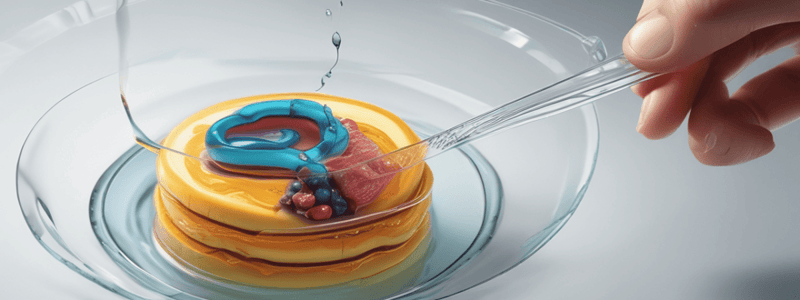Podcast
Questions and Answers
Define surface tension.
Define surface tension.
Surface tension is the tendency of the surface of a liquid to behave like a stretched elastic membrane.
What happens to the surface tension of liquids as the temperature increases?
What happens to the surface tension of liquids as the temperature increases?
- Decreases (correct)
- Varies randomly
- Stays the same
- Increases
Surface tension is expressed as free energy per unit surface area or work required to extend a surface under isothermal conditions. It is also defined as the force per unit length on the surface that opposes the ______ of the surface.
Surface tension is expressed as free energy per unit surface area or work required to extend a surface under isothermal conditions. It is also defined as the force per unit length on the surface that opposes the ______ of the surface.
expansion
Foams form more easily in liquids with low surface tension.
Foams form more easily in liquids with low surface tension.
What provides stability to foams?
What provides stability to foams?
Which of the following statements about emulsions is true?
Which of the following statements about emulsions is true?
What is the primary reason for the high viscosity of emulsions?
What is the primary reason for the high viscosity of emulsions?
Which of the following is an example of a water-in-oil emulsion?
Which of the following is an example of a water-in-oil emulsion?
What is the term used to describe the amount of air incorporated into a foam?
What is the term used to describe the amount of air incorporated into a foam?
What is the primary reason for the importance of foams in food products?
What is the primary reason for the importance of foams in food products?
What is the characteristic of a liquid that makes it more likely to form a foam?
What is the characteristic of a liquid that makes it more likely to form a foam?
Which of the following is a characteristic of emulsifiers and detergents?
Which of the following is a characteristic of emulsifiers and detergents?
What is the mathematical expression for overrun in a foam?
What is the mathematical expression for overrun in a foam?
Which of the following is a factor that determines the stability of an emulsion?
Which of the following is a factor that determines the stability of an emulsion?
What is the term used to describe the boundary between two immiscible liquids?
What is the term used to describe the boundary between two immiscible liquids?
Why does a small droplet of a liquid adapt its shape to an almost perfect sphere?
Why does a small droplet of a liquid adapt its shape to an almost perfect sphere?
What is the unit of surface tension in the SI system?
What is the unit of surface tension in the SI system?
What is the term used to describe the surface tension at the boundary between two liquids?
What is the term used to describe the surface tension at the boundary between two liquids?
What happens to the shape of a droplet as its size increases?
What happens to the shape of a droplet as its size increases?
What is the reason for the decrease in surface tension of a liquid as the temperature increases?
What is the reason for the decrease in surface tension of a liquid as the temperature increases?
What is the force that opposes the expansion of a liquid surface?
What is the force that opposes the expansion of a liquid surface?
What is the term used to describe the process of creating a mixture of two or more liquids that don't normally mix?
What is the term used to describe the process of creating a mixture of two or more liquids that don't normally mix?
What is the relationship between surface tension and the shape of a droplet?
What is the relationship between surface tension and the shape of a droplet?
What happens to the surface tension value at the critical temperature?
What happens to the surface tension value at the critical temperature?
What is the term used to describe the mixture of air bubbles in a liquid?
What is the term used to describe the mixture of air bubbles in a liquid?
Which of the following is NOT a characteristic of a liquid with high surface tension?
Which of the following is NOT a characteristic of a liquid with high surface tension?
Why is it important for foam-forming liquids to have low vapor pressure?
Why is it important for foam-forming liquids to have low vapor pressure?
What is the primary function of incorporating solid matter into foam films?
What is the primary function of incorporating solid matter into foam films?
What is the primary role of denaturation in protein foams?
What is the primary role of denaturation in protein foams?
What is the primary purpose of a contact angle goniometer?
What is the primary purpose of a contact angle goniometer?
Why do foams collapse quickly in liquids with high surface tension?
Why do foams collapse quickly in liquids with high surface tension?
What is the primary advantage of using a video-based contact angle meter?
What is the primary advantage of using a video-based contact angle meter?
What is the primary role of surface tension in foams?
What is the primary role of surface tension in foams?
Why do liquids with low surface tension form foams more easily?
Why do liquids with low surface tension form foams more easily?
Which of the following is NOT a method for measuring surface tension?
Which of the following is NOT a method for measuring surface tension?
What is the primary reason for the high viscosity of emulsions compared to the viscosities of either of the liquids?
What is the primary reason for the high viscosity of emulsions compared to the viscosities of either of the liquids?
What determines the stability of an emulsion?
What determines the stability of an emulsion?
What is the mathematical expression for overrun in a foam?
What is the mathematical expression for overrun in a foam?
Why do foams form more easily in liquids with low surface tension?
Why do foams form more easily in liquids with low surface tension?
What is the primary role of emulsifiers and detergents?
What is the primary role of emulsifiers and detergents?
What is the characteristic of a liquid that makes it more likely to form a foam?
What is the characteristic of a liquid that makes it more likely to form a foam?
Why do emulsions have high viscosities?
Why do emulsions have high viscosities?
What is the term used to describe the boundary between two immiscible liquids?
What is the term used to describe the boundary between two immiscible liquids?
What is the primary reason for the importance of foams in food products?
What is the primary reason for the importance of foams in food products?
What determines the stability of a foam?
What determines the stability of a foam?
In a foam, what is the primary cause of the collapse of the foam cells?
In a foam, what is the primary cause of the collapse of the foam cells?
Which of the following is a characteristic of a liquid that is most likely to form a stable foam?
Which of the following is a characteristic of a liquid that is most likely to form a stable foam?
What is the primary advantage of incorporating solid matter into foam films?
What is the primary advantage of incorporating solid matter into foam films?
What is the primary role of denaturation in protein foams?
What is the primary role of denaturation in protein foams?
What is the primary purpose of a contact angle goniometer?
What is the primary purpose of a contact angle goniometer?
Why do foams form more easily in liquids with low surface tension?
Why do foams form more easily in liquids with low surface tension?
What is the primary reason why liquids with high surface tension are less likely to form foams?
What is the primary reason why liquids with high surface tension are less likely to form foams?
What is the primary advantage of using a video-based contact angle meter?
What is the primary advantage of using a video-based contact angle meter?
Why is it important for foam-forming liquids to have low vapor pressure?
Why is it important for foam-forming liquids to have low vapor pressure?
What is the primary role of surface tension in foams?
What is the primary role of surface tension in foams?
What is the primary reason why small droplets of liquids adapt their shape to an almost perfect sphere, whereas larger droplets become flatter?
What is the primary reason why small droplets of liquids adapt their shape to an almost perfect sphere, whereas larger droplets become flatter?
Which of the following is a consequence of high surface tension in a liquid?
Which of the following is a consequence of high surface tension in a liquid?
What is the primary purpose of measuring the surface tension of a liquid in the context of emulsions?
What is the primary purpose of measuring the surface tension of a liquid in the context of emulsions?
What is the term used to describe the tension that arises at the interface between two immiscible liquids?
What is the term used to describe the tension that arises at the interface between two immiscible liquids?
Which of the following statements about foams is true?
Which of the following statements about foams is true?
What is the primary reason why emulsions are more stable when the interfacial tension is low?
What is the primary reason why emulsions are more stable when the interfacial tension is low?
What is the relationship between surface tension and viscosity in the context of foam formation?
What is the relationship between surface tension and viscosity in the context of foam formation?
What is the primary role of surface tension in the formation of emulsions?
What is the primary role of surface tension in the formation of emulsions?
Which of the following is a characteristic of a liquid with low surface tension?
Which of the following is a characteristic of a liquid with low surface tension?
What happens to the interfacial tension between two immiscible liquids as the temperature increases?
What happens to the interfacial tension between two immiscible liquids as the temperature increases?
Flashcards are hidden until you start studying
Study Notes
Surface Properties of Food
Surface Tension
- Surface tension is the tendency of a liquid's surface to behave like a stretched elastic membrane.
- Liquids with high surface tension values also have high latent heat values.
- Surface tension decreases as temperature increases, and becomes very low near the critical temperature.
- Surface tension (σ) is expressed as free energy per unit surface area or the work required to extend a surface under isothermal conditions.
- It can be measured in N/m, and appears in situations involving free surfaces or interfaces.
Interfacial Tension
- Interfacial tension arises at the boundary of two immiscible liquids due to an imbalance of intermolecular forces.
- Emulsifiers and detergents function by lowering interfacial tension.
- The higher the interfacial tension, the lower the solubility of the solvents in each other.
Emulsions
- An emulsion is a colloidal system in which a liquid is dispersed as droplets in another liquid with which it is immiscible.
- Emulsions can be classified as oil-in-water (o/w) and water-in-oil (w/o) emulsions.
- Examples of o/w emulsions include mayonnaise, and w/o emulsions include butter.
- Emulsion viscosities are very high compared to the viscosities of either of the liquids.
- The stability of emulsions can be determined by the viscosity of the continuous phase, the presence and concentration of emulsifier, the size of the droplets, and the ratio of dispersed phase to continuous phase.
Foams
- A foam is a colloidal dispersion in which gas is the dispersed phase and liquid is the continuous phase.
- Examples of foams include ice cream, whipped cream, or cake batter.
- Foams are important due to their contribution to volume and texture of food products.
- The inclusion of air reduces the density of the product, and the term overrun is used to describe the amount of air incorporated.
- Liquids should have low surface tension to form foams, and low vapor pressure to prevent evaporation and retain the gaseous phase.
- Stability can be provided to foams by incorporating solid matter into the films to increase the rigidity of the walls surrounding the gas.
Contact Angle Measurement Methods
- Contact angle can be measured with a contact angle goniometer or an inexpensive video-based contact angle meter.
Surface Tension Measurement Methods
- Surface tension can be measured using the drop weight method, bubble pressure method, capillary rise method, or tensiometer dynamic methods.
Interfacial Tension
- Arises at the boundary of two immiscible liquids due to the imbalance of intermolecular forces
- Emulsifiers and detergents function by lowering the interfacial tension
- The higher the interfacial tension, the lower is the solubility of the solvents in each other
Emulsions
- A colloidal system in which a liquid is dispersed as droplets in another liquid with which it is immiscible
- Can be classified as oil-in-water (o/w) and water-in-oil emulsions (w/o)
- In oil-in-water emulsions, oil is dispersed in water as droplets
- In water-in-oil emulsions, droplets of water are dispersed in oil
- Viscosities of emulsions are very high as compared to the viscosities of either of the liquids
- Stability of emulsions can be determined by the viscosity of the continuous phase, the presence and concentration of emulsifier, the size of the droplets, and the ratio of dispersed phase to the continuous phase
Foams
- A colloidal dispersion in which gas is the dispersed phase and liquid is the continuous phase
- Examples: ice cream, whipped cream, or cake batter
- Foams are important because of their contribution to volume and texture of food products
- The inclusion of air reduces the density of the product
- Overrun is used to describe the amount of air incorporated in foams: Vf (volume of the foam) / Vl (volume of the original liquid)
Surface Tension
- Tendency of a surface of a liquid to behave like a stretched elastic membrane
- Liquids that have high surface tension values also have high latent heat values
- Surface tensions of most liquids decrease as the temperature increases
- Surface tension value becomes very low in the region of critical temperature as the intermolecular cohesive forces approach zero
- Surface tension (σ) is expressed as free energy per unit surface area or work required to extend a surface under isothermal conditions
- Unit for surface tension in the SI system is N/m
- Surface tension appears in situations involving either free surfaces (liquid–gas or liquid–solid boundaries) or interfaces (liquid–liquid boundaries)
Foam Stability
- Liquids should have low surface tension to form foams
- Liquids should have low vapor pressure to prevent evaporation
- Stability can be provided to foams if some solid matter can be incorporated into the films to increase the rigidity of the walls surrounding the gas
- In protein foams, the denaturation of the protein provides stability to cell walls
Interfacial Tension
- Arises at the boundary of two immiscible liquids due to an imbalance of intermolecular forces
- Can be lowered by emulsifiers and detergents
- Higher interfacial tension generally means lower solubility of solvents in each other
Emulsions
- A colloidal system where a liquid is dispersed as droplets in another liquid with which it is immiscible
- Can be classified as oil-in-water (o/w) and water-in-oil (w/o) emulsions
- Examples: mayonnaise (o/w), butter (w/o)
- Emulsion viscosities are very high compared to the viscosities of either of the liquids
Factors Affecting Emulsion Stability
- Viscosity of the continuous phase
- Presence and concentration of emulsifier
- Size of the droplets
- Ratio of dispersed phase to the continuous phase
Foams
- A colloidal dispersion where gas is the dispersed phase and liquid is the continuous phase
- Examples: ice cream, whipped cream, cake batter
- Foams are important due to their contribution to volume and texture of food products
- Inclusion of air reduces the density of the product
- Overrun is the amount of air incorporated into the foam
Formation of Foams
- Liquids should have low surface tension to form foams
- Low surface tension allows easy stretching and spreading, and prevents coalescence
- Liquids should have low vapor pressure to prevent evaporation and retain the gaseous phase
- Incorporating solid matter into the films can increase the rigidity of the walls surrounding the gas
- Denaturation of protein provides stability to cell walls in protein foams
Contact Angle Measurement
- Can be measured using a contact angle goniometer or a video-based contact angle meter
- The instrument consists of a light source, an illuminating stage, and a telescope
Surface Tension
- Tendency of a surface of a liquid to behave like a stretched elastic membrane
- Liquids with high surface tension values also have high latent heat values
- Surface tension decreases as temperature increases and approaches zero near critical temperature
- Surface tension is expressed as free energy per unit surface area or work required to extend a surface under isothermal conditions
Units and Dimensions of Surface Tension
- Expressed in units of N/m in the SI system
- Has dimensions of force per unit length
- Appears in situations involving free surfaces (liquid-gas or liquid-solid boundaries) or interfaces (liquid-liquid boundaries)
Studying That Suits You
Use AI to generate personalized quizzes and flashcards to suit your learning preferences.




